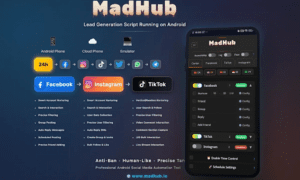As eCommerce operations become more complex, Magento store owners face an increasing need for backend efficiency and real-time connectivity. Enter the Magento integration platform: a solution designed to eliminate data silos and automate workflows by connecting Magento with ERPs, CRMs, marketplaces, and more. In this blog, we’ll explore the top 5 Magento integration platforms of 2025, breaking down their features, pros, and ideal use cases to help you choose the right fit for your business.
Why Choose a Magento Integration Platform?
Magento is a powerful commerce engine, but it doesn’t operate in a vacuum. Merchants typically run multiple systems like accounting, inventory, CRM, shipping that need to communicate seamlessly. A Magento integration platform, often called a Magento iPaaS (Integration Platform as a Service), acts as a middleware layer that automates this data exchange.
According to Adobe, Magento merchants process over $155 billion in gross merchandise volume annually. As operations scale, a reliable integration platform ensures that order data, customer records, and inventory updates flow in real time across systems—minimizing manual errors and boosting efficiency.
Competitive Landscape Overview
If you’ve searched for Magento integration, you’ve likely encountered names like Celigo, Jitterbit, Burq iPaaS, Workato, and Cyclr. These platforms dominate search results, but often fall short of deep Magento-specific insights. Below, we evaluate each based on native Magento support, scalability, ease of use, and real-world application.
5 Best Magento Integration Platforms for 2025
1. Celigo
Key Features: Pre-built Magento connectors, NetSuite integration, order-to-cash workflows.
Pros: Fast deployment, scalable, strong ERP support.
Cons: Higher pricing for smaller businesses.
Best For: Mid-market merchants integrating Magento with NetSuite or QuickBooks.
2. Jitterbit
Key Features: Low-code interface, real-time data sync, extensive error-handling capabilities.
Pros: High reliability, 40% fewer integration errors (source: G2 reviews).
Cons: Learning curve for non-technical users.
Best For: Companies needing robust error management and flexible integrations.
3. Burq
Key Features: Full-stack Magento integration, real-time sync with ERP, CRM, marketplaces, and shipping systems.
Pros: Customizable connectors, excellent support, optimized for Magento workflows.
Cons: Currently scaling global support.
Best For: Magento merchants seeking end-to-end automation and scalable architecture.
4. Workato
Key Features: 1,200+ app connectors, powerful automation engine.
Pros: Ideal for cross-functional automation, wide ecosystem.
Cons: Overpowered for simple Magento stores.
Best For: Tech-savvy teams managing multiple systems beyond Magento.
5. Cyclr
Key Features: Embedded iPaaS, drag-and-drop UI, white-label options.
Pros: Fast integration, great for SaaS vendors.
Cons: Less native Magento depth.
Best For: SaaS platforms embedding Magento integrations in their services.
Magento iPaaS vs Custom vs Traditional Middleware
Traditional integration methods often rely on custom code or rigid middleware. While these solutions work, they tend to be inflexible, require substantial developer involvement, and demand frequent updates to remain compatible with evolving systems. Middleware solutions, while powerful, are often complex and come with higher long-term maintenance costs.
A Magento iPaaS integration platform offers a more agile, scalable, and cost-effective alternative. These platforms provide real-time synchronization between Magento and external systems like ERPs, CRMs, and fulfillment tools. They also include pre-built connectors, low-code customization, and centralized dashboards to monitor integration health. As a result, Magento iPaaS solutions not only reduce integration timelines but also empower non-technical users to manage workflows, making them ideal for modern, fast-scaling commerce operations.
Notable Mentions
While not in the top five, platforms like DCKAP Integrator, Amasty’s Integration Suite, and VL OMNI offer niche advantages for specialized use cases like headless Magento setups or SAP-heavy operations.
Quick Decision Guide
| Business Type | Recommended Platform |
| SMB w/ ERP needs | Celigo |
| Enterprise w/ SAP | Burq |
| Multi-channel SaaS | Cyclr |
| High-volume order sync | Jitterbit |
| Complex automation workflows | Workato |
Conclusion
Selecting a Magento integration platform is no longer optional, it’s essential to stay competitive in the rapidly evolving eCommerce landscape. The right solution ensures seamless data flow, supports scalability, and enables automation across your tech stack, ultimately driving operational efficiency and growth.
Whether you’re focused on speed, flexibility, deep ERP integration, or user-friendly interfaces, there’s a platform built to support your needs. Evaluate your current setup, future plans, and resource availability. Platforms like Burq offer a unified, modern approach to integration that simplifies complexity while delivering long-term value.
Need expert guidance to implement the Magento iPaaS integration for your business? Talk to the Burq team today and start automating smarter.
FAQs
- What is a Magento integration platform?
It’s a solution that connects Magento with external systems like ERPs and CRMs to automate data sync. - How is a Magento iPaaS different from traditional middleware?
An iPaaS is cloud-based, scalable, and user-friendly, unlike traditional middleware that requires heavy configuration. - Can I integrate Magento with multiple systems at once?
Yes, a good Magento integration platform supports multi-point connections. - What should I look for in a Magento integration solution?
Real-time sync, error handling, native Magento support, and scalability. - Is custom Magento integration better than using an iPaaS?
Custom integrations offer control but are costly to maintain; iPaaS provides agility and faster time to value.



































